Key takeaways:
- Selective mutism is an anxiety disorder often misinterpreted as shyness, affecting both children and adults.
- Recognizing triggering situations is crucial; environments with noise and social pressure can heighten anxiety for individuals with selective mutism.
- Grounding techniques like mindful breathing, visualization, and journaling are effective in managing anxiety and fostering calmness.
- Creating a supportive environment through empathetic communication and familiar settings can significantly aid individuals dealing with selective mutism.
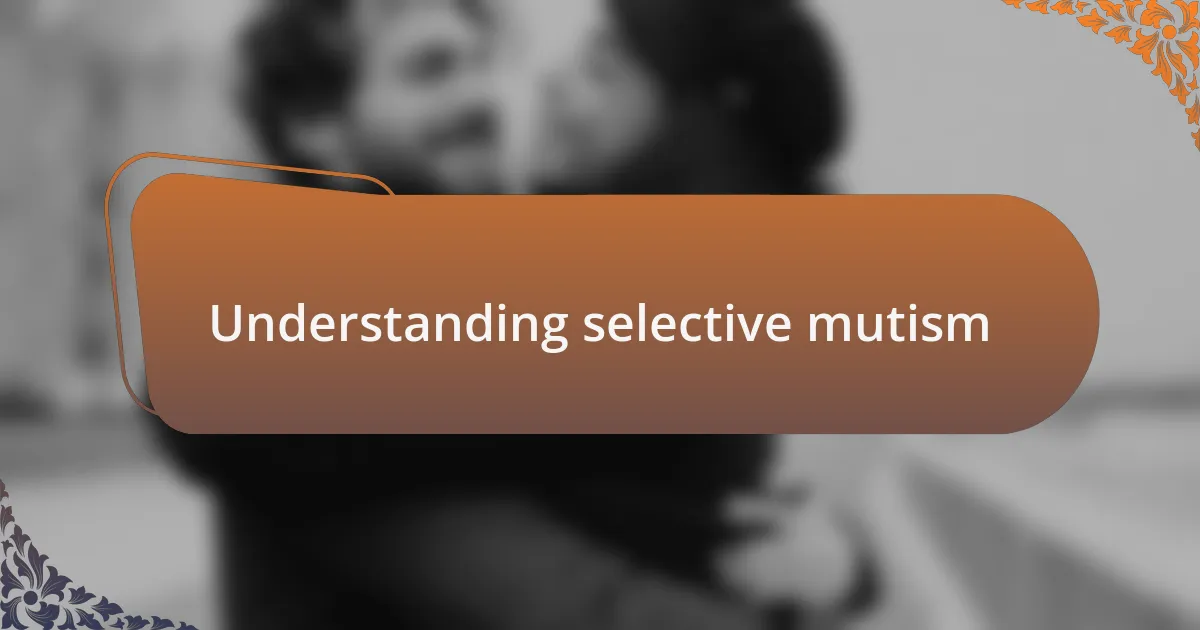
Understanding selective mutism
Selective mutism is a complex anxiety disorder that often manifests in children, but it can also affect adults. I remember a time when a close friend of mine struggled to speak in social settings, even with familiar faces around. It left me wondering what was happening inside her mind—why do some people find it so hard to express themselves verbally, even when they desperately want to be heard?
At its core, selective mutism isn’t just about shyness; it’s deeply rooted in anxiety. I’ve seen individuals freeze, as if paralyzed by the expectation to talk, while their thoughts race. It really made me appreciate how crucial it is to create supportive environments, where people feel safe to find their voice, even if it takes time.
Many people might not realize that selective mutism is not a choice; it’s a response to overwhelming fear. It can feel isolating, and moments of silence can stretch out painfully. Have you considered how much pressure we place on communication in social settings? Understanding this can be a vital step in fostering empathy and support for those navigating these challenging waters.
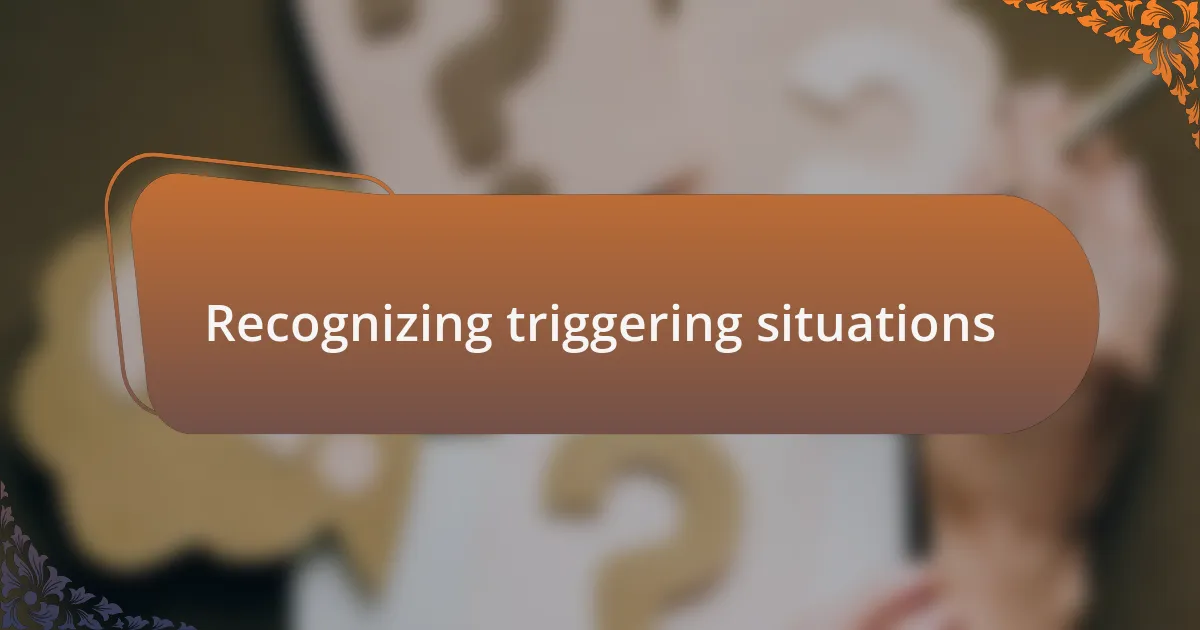
Recognizing triggering situations
Recognizing triggering situations can be a vital step in understanding how selective mutism affects individuals. I recall a time when I was at a family gathering, and the noise and chatter felt overwhelming to me. It dawned on me that not only were the sounds triggering for me, but they must be even more daunting for someone with selective mutism, who might feel an immense weight to participate yet remain silent.
There are certain contexts—like crowded rooms or unexpected social interactions—that can set off heightened anxiety. I’ve noticed how my own heart races in those environments, making me reflective of how others might feel. Have you ever observed someone widening their eyes or shifting nervously in a social setting? Those subtle cues can reveal a deeper discomfort, often rooted in triggers that make verbal communication feel impossible.
In conversations, I find that understanding emotional cues can help to identify when someone may be feeling overwhelmed. For instance, I’ve seen close friends go quiet when the pressure to respond escalates, pulling back instead of engaging. Recognizing these subtle shifts is essential; it’s like tuning into an invisible frequency that can guide us in providing the understanding and support that someone with selective mutism truly needs.
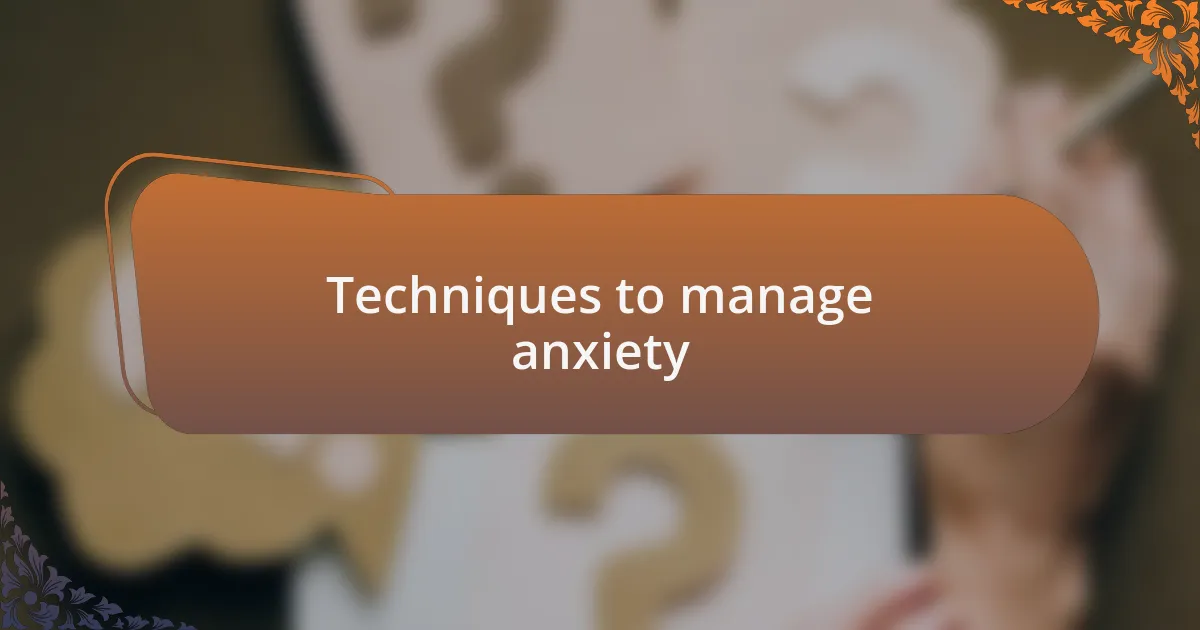
Techniques to manage anxiety
When faced with anxiety, grounding techniques have always served me well. For example, whenever I feel overwhelmed, I focus on my breath, inhaling deeply through my nose and exhaling slowly. This simple action helps me tune into my body and anchor myself in the present moment, reminding me that I’m in control, even when everything feels chaotic.
Another approach I’ve found effective is creating a safe space in my mind. I picture a serene place—a cozy room with soft lighting or a tranquil beach where the waves gently lap the shore. When anxiety strikes, I close my eyes and mentally transport myself there. Have you ever tried visualizing a comforting environment? This technique can provide a much-needed reprieve from the noise of external triggers.
Journaling also plays a crucial role in managing my anxiety. Putting my thoughts on paper transforms my overwhelming emotions into manageable ideas. I often jot down what I’m feeling and what might have triggered those feelings. Have you ever noticed how expressing your thoughts can lighten the emotional burden? It fosters a deeper understanding of your triggers, making it easier to cope with them in the future.
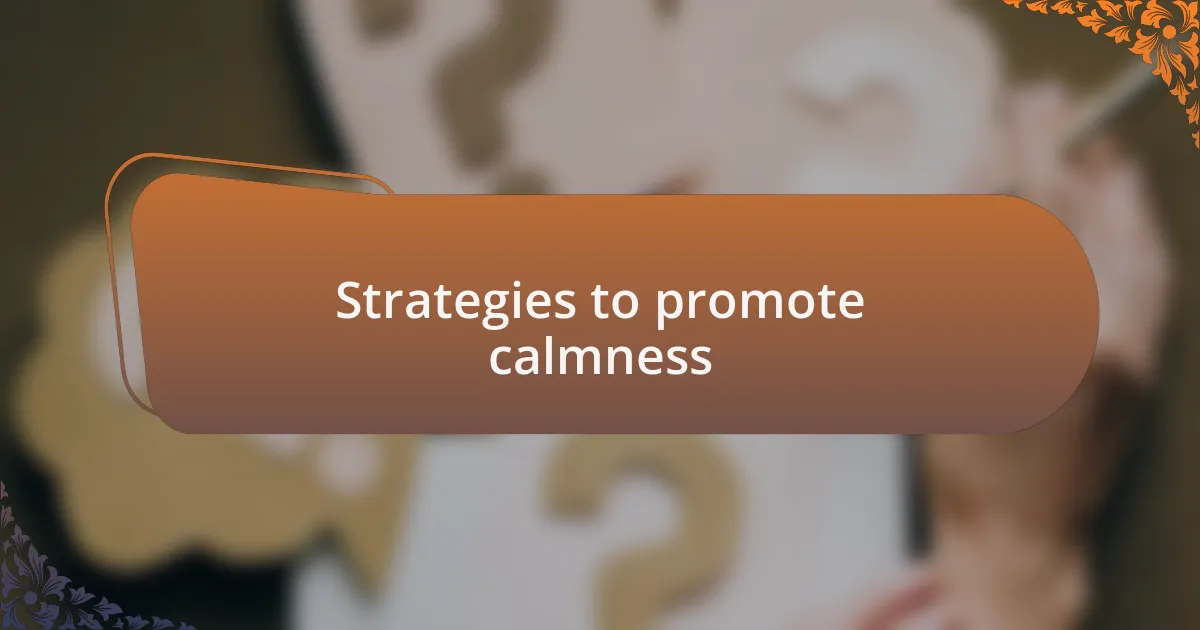
Strategies to promote calmness
One strategy that never fails to bring me calm is practicing mindfulness. When I feel the stirrings of anxiety, I often take a moment to observe my surroundings. I notice the colors, sounds, and scents around me, allowing them to ground me. Have you ever stopped to just listen to the world? This awareness can be a powerful antidote to anxiety, helping me reconnect with the present.
I’ve also found that engaging in a physical activity can significantly alleviate stress. Whether it’s a brisk walk or a few minutes of stretching, moving my body releases tension and boosts my mood. I remember one particularly stressful day when a short jog turned my entire mindset around. How powerful is it to feel your body working for you? That sense of physicality often shifts my focus away from what’s troubling me.
Additionally, I’ve turned to music as a calming companion in moments of anxiety. Creating playlists of soothing melodies transforms my mood and environment. I recall a time when I was feeling overwhelmed before a social event; I played my favorite calming tunes and felt my heart rate slow. Isn’t it remarkable how music can evoke such profound shifts in our emotions? Choosing to surround myself with uplifting sounds has become an intentional practice in managing my anxiety.
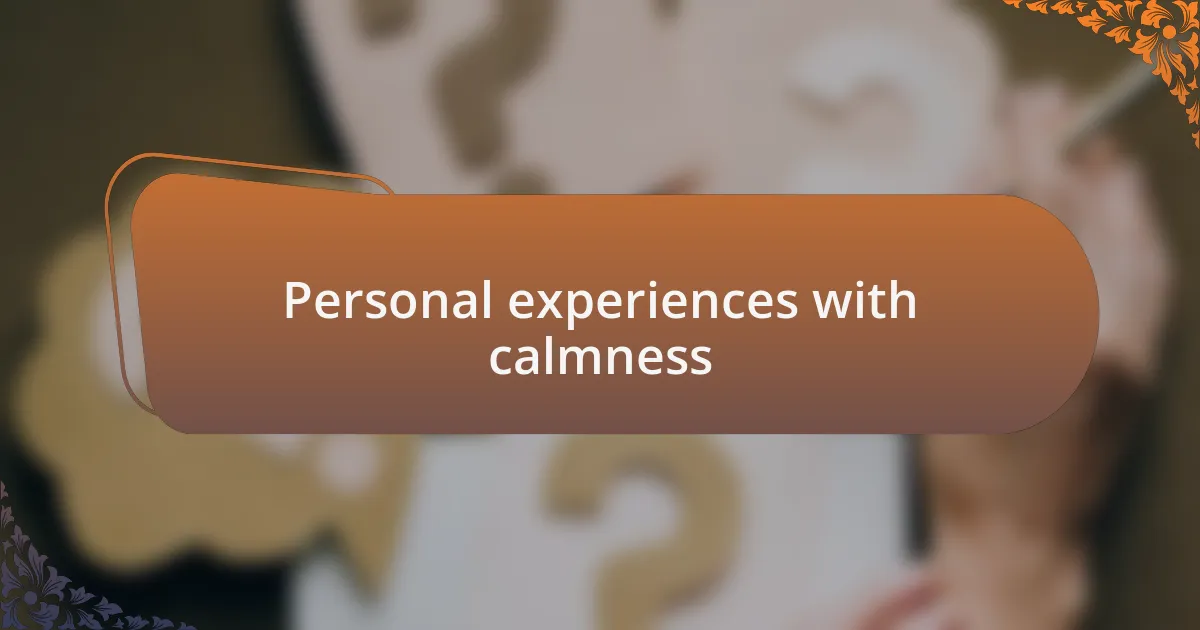
Personal experiences with calmness
There have been moments when simply stepping outside has been my refuge. I remember feeling overwhelmed at a family gathering, where the noise and interactions felt like suffocating waves. Stepping into the cool air, I closed my eyes and took a deep breath. Have you ever experienced such relief in a simple act? It’s as if the outside world whispers reassurances while I reconnect with myself.
In other situations, I’ve discovered that writing in a journal serves as an emotional outlet. When I faced a particularly challenging day, I poured my thoughts onto the page, allowing my feelings to flow freely. This act of expressing what I was going through brought a surprising sense of clarity and calm. Isn’t it fascinating how translating chaos into words can restore inner peace?
Another personal strategy has been creating a cozy corner in my home. When life feels too much, retreating to this space surrounded by soft blankets, warm lighting, and a good book is my sanctuary. I vividly recall a rainy afternoon when I settled into my nook, tuning out external stressors. Have you ever found solace in a special place? That little corner has become my anchor, reminding me that calm exists even amidst turmoil.
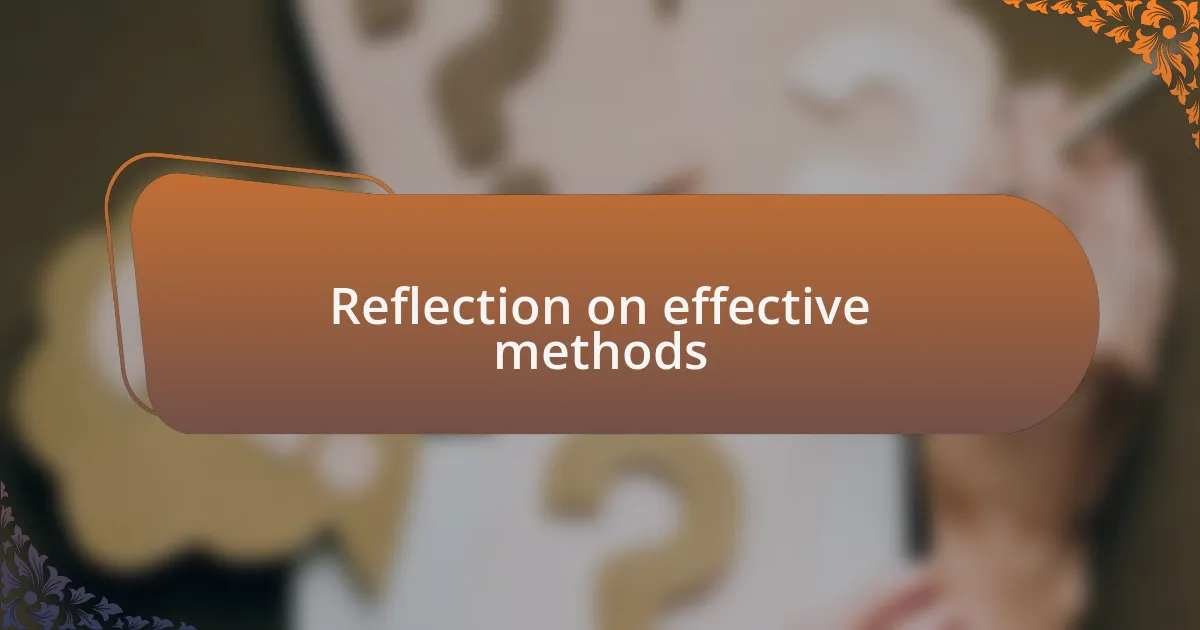
Reflection on effective methods
Finding effective methods to cultivate calmness in triggering situations has been a journey of discovery for me. One approach that has really resonated is mindful breathing. I remember sitting in a waiting room, feeling the anxiety creep in. I intentionally focused on my breath, inhaling slowly while picturing a serene landscape. Have you ever tried visualizing a peaceful place while you breathe? It’s incredible how that simple practice can ground you in the moments of chaos.
Another method that has proven beneficial is engaging in light exercise. I’ve found that going for a brisk walk, even for just ten minutes, does wonders for my state of mind. On a particularly stressful day, I decided to step outside for a jog. The rhythm of my feet hitting the pavement seemed to shake off the heavy weight of worries. Isn’t it amazing how movement can free your thoughts and clear the mental fog?
Additionally, I’ve explored the power of music as a therapeutic tool. During tough times, I often create playlists filled with calming tunes. One evening, feeling utterly overwhelmed, I slipped on my headphones and let the melodies wash over me. The right song can transport you, can’t it? That night, each note wrapped around my worries, creating a soothing barrier between me and the stressors of life.

Building a supportive environment
Creating a supportive environment is crucial for navigating triggering situations. I remember one day when everything felt overwhelming. I turned to my family, who had recently learned about my struggles with selective mutism. Their warm words and understanding nods created such a safe space that it felt like a mental hug. Isn’t it amazing how simply being surrounded by empathetic people can help us breathe a little easier?
Sometimes, it’s the little things that count in building support. I often find solace in familiar settings, like my cozy reading nook at home. On a particularly tense day, I retreated to that same spot, surrounded by my favorite books and soft lighting. The comforting presence of those well-worn pages reminded me that I could create a bubble of calm, buffered from external pressures. Have you ever had a place like that, where you felt instantly at ease?
In addition to the physical environment, clear communication can foster understanding and support. I initiated open dialogues with my friends about what triggers me, and their responses were heartwarming. They embraced my feelings without judgment, and often, they checked in with me beforehand in social situations. This proactive approach has made a significant difference; it’s like having a personal support crew ready to dive in whenever I need it. Doesn’t having that kind of understanding make all the difference?